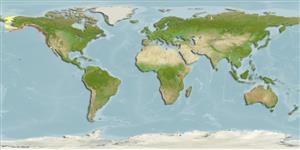Common names from other countries
Environment: milieu / climate zone / depth range / distribution range
Écologie
; profondeur 0 - 60 m (Ref. 95344). Subtropical
Distribution
Pays | Zones FAO | Écosystèmes | Occurrences | Introductions
Eastern Pacific and the Arctic: Alaska to California. Subtropical to boreal.
Length at first maturity / Taille / Poids / Âge
Maturity: Lm ? range ? - ? cm Max length : 9.0 cm SHL mâle / non sexé; (Ref. 865); common length : 8.0 cm SHL mâle / non sexé; (Ref. 312)
Description synthétique
Morphologie
Description: Shell has spiral ridges. Has at least three prominent wing-like structures, worn off in older snails. Color is brown and white to creamy-white. Young snails have tooth-like projections on the lip of the shell (Ref. 312).
Occurs in the low intertidal zone. Uses the radula to bore through the calcareous shells of its prey (clams, mussels, and barnacles; Ref. 312) (Ref. 312).
Life cycle and mating behavior
Maturité | Reproduction | Frai | Œufs | Fécondité | Larves
This species is a non-broadcast spawner. Life cycle does not include trocophore stage. Also Ref. 833.
Gallivan, G. and J. Danforth. 1999. (Ref. 312)
Statut dans la liste rouge de l'IUCN (Ref. 130435)
statut CITES (Ref. 108899)
Not Evaluated
Not Evaluated
Utilisations par l'homme
| FishSource |
Outils
Plus d'informations
Taille/ÂgeCroissanceLongueur-poidsLongueur-longueurMorphologieLarvesAbondance
Sources Internet
Estimates based on models
Preferred temperature
(Ref.
115969): 5.7 - 12, mean 8.9 (based on 132 cells).
Catégorie de prix
Unknown.
